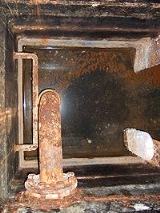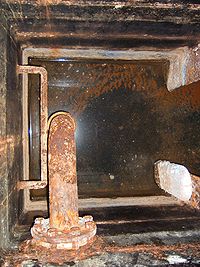
Bilge
Encyclopedia

Bilge water
The word is sometimes also used to describe the water that collects in this compartment. Water that does not drain off the side of the deck drains down through the ship into the bilge. This water may be from rough seas, rain, minor leaks in the hull, other interior spillage, or stuffing box. The water that collects in the bilge must be pumped out to prevent the bilge from becoming too full and threatening to sink the ship.Bilge water can be found aboard almost every vessel. Depending on the ship's design and function, bilge water may contain water, oil, urine, detergents, solvents, chemicals, pitch, particles, and so forth.
By housing water in a compartment, the bilge keeps these liquids below decks, making it safer for the crew to operate the vessel and for people to move around in strong weather.
Bilge pumping
The development of bilge pumpBilge pump
A bilge pump is a water pump used to remove bilge water. Since fuel can be present in the bilge, electric bilge pumps are designed to not cause sparks. Electric bilge pumps are often fitted with float switches which turn on the pump when the bilge fills to a set level. Since bilge pumps can fail,...
s went from bucket
Bucket
A bucket, also called a pail, is typically a watertight, vertical cylinder or truncated cone, with an open top and a flat bottom, usually attached to a semicircular carrying handle called the bail. A pail can have an open top or can have a lid....
s, to hand pumps, and now electric bilge pumps are available for even small vessels. Bilge coatings are applied to protect the bilge surfaces. The water that collects is often noxious, and "bilge water" or just "bilge" has thus become a derogatory colloquial term used to refer to something bad, fouled, or otherwise offensive.
A feature of the bilge is the swash plates, which serve to damp the rush of water from side to side, which might destabilize the ship if allowed to run freely. The swash plates run fore and aft and have small openings near the bottom where the water is allowed to run through.
Cleaning the bilge and bilge water is also possible using "passive" methods such as bioremediation
Bioremediation
Bioremediation is the use of microorganism metabolism to remove pollutants. Technologies can be generally classified as in situ or ex situ. In situ bioremediation involves treating the contaminated material at the site, while ex situ involves the removal of the contaminated material to be treated...
, which uses bacteria to break down the hydrocarbons in the bilge water into harmless byproducts. Of the two general schools of thought on bioremediation, the one that uses bacteria local to the bilge are regarded as more "green" because they don't introduce foreign bacteria to the waters that the boat sits in or travels through.
The term "bilged" refers to the deliberate flooding of the bilge in order to incapacitate the ship, to slow its speed or to make it hard or impossible to handle. This process may be carried out by enemy action, such as in the Battle of Vigo Bay
Battle of Vigo Bay
The Battle of Vigo Bay, also known as the Battle of Rande , was a naval engagement fought on 23 October 1702 during the opening years of the War of the Spanish Succession. The engagement followed an Anglo-Dutch attempt to capture the Spanish port of Cádiz in September in an effort to secure a naval...
, or by the crew of the ship itself in order to save it from falling into enemy hands, where a Spanish
Spanish Navy
The Spanish Navy is the maritime branch of the Spanish Armed Forces, one of the oldest active naval forces in the world. The Armada is responsible for notable achievements in world history such as the discovery of Americas, the first world circumnavigation, and the discovery of a maritime path...
ship was grounded
Ship grounding
Ship grounding is a type of marine accident that involves the impact of a ship on the seabed, resulting in damage of the submerged part of her hull and particularly the bottom structure, potentially leading to water ingress and compromise of the ship's structural integrity and stability...
and bilged. It could later be recovered by being pumped out and re-floated during a high tide.

